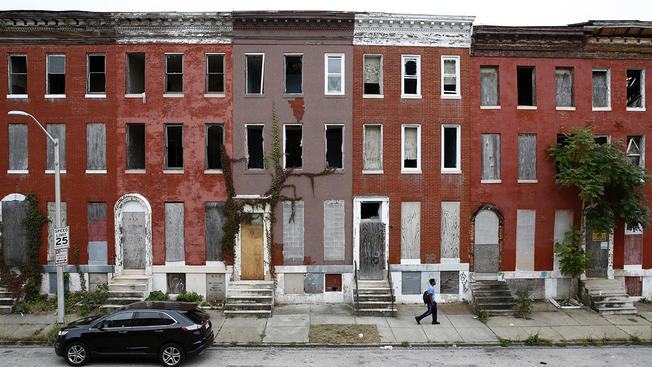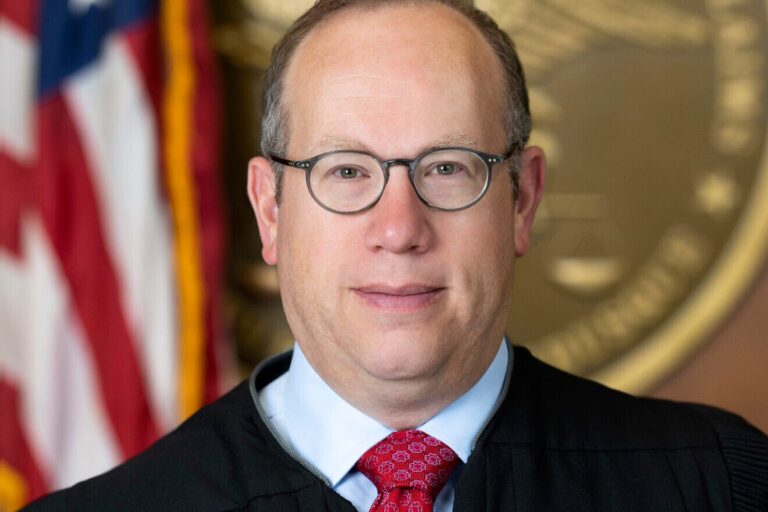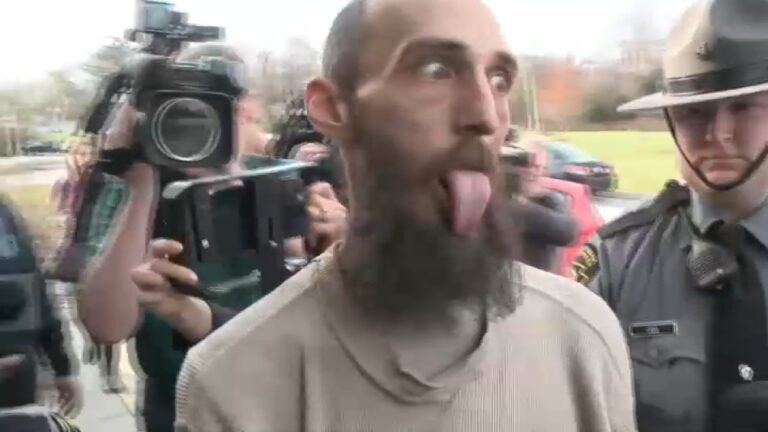LaShelle Rollins’ rental house in West Baltimore is wedged between a line of derelict properties valued only by street gangs, drug addicts and firefighters conducting arson drills. And even though her family’s $700-a-month address sits across from a public school, they are among the only occupants of this desolate block.
Life in an emptied-out, rundown cityscape is a slog and Rollins is worn out by all of it: The sounds of late-night interlopers stomping down the stairs of a musty wreck next door; a constant fear of fire set by vandals; the social isolation; the rats. With no faith in a prompt police response, they keep a bat at the ready.
“It’s like we’re a forgotten population,” said Rollins, a Baltimore native who’s studying for a community college degree that she hopes will get her family out of this gloomy neighborhood — maybe even out of the city that part of her still loves.
The African-American woman with a bright-eyed 6-year-old daughter and a husband on disability isn’t the only one with leaving on her mind. At a time when rival cities are gaining population, Baltimore’s decades-long disappearing act is only continuing.
In 1950, Baltimore was America’s sixth most populous city, with nearly a million residents, many employed by Bethlehem Steel. Over decades, with factories closed and “white flight” in the 1960s and ’70s followed by waves of “black flight,” it’s shrunk to the country’s 30th largest, a loss of nearly 350,000 people.
According to U.S. Census estimates, Baltimore led all American cities in population loss for the last two years running. Census figures indicate the city saw more people leave its boundaries than Chicago, which also reported significant losses, even though Baltimore is only a quarter of its size.
Even with job gains, stately historic districts, and gleaming waterfront areas, Baltimore overall has about the same population today as it did 100 years ago. Only 17 of Baltimore’s 55 communities gained households between 2010 and 2016, according to the Baltimore Neighborhood Indicators Alliance. Many are in the city’s prosperous and mostly white areas.
Maryland’s biggest city is hardly alone in dealing with issues of urban decay. Nationwide, places like Detroit and Newark have struggled with similar problems. Out of 33 U.S. cities with a population larger than 500,000, only Baltimore and Detroit have seen overall declines since 2010.
But Baltimore’s sea of vacant lots and roughly 16,000 uninhabitable row homes with weeds growing out of boarded-up windows have proven especially intractable in racially segregated, deeply poor areas. Housing researchers say some 20,000 other city properties are unoccupied and pose a risk of becoming crumbling shells. They largely sit in downtrodden swaths of West and East Baltimore.
Those predominantly African-American neighborhoods with a concentration of derelict buildings offer ghostly scenes: A silenced piano coated in chipped paint, bowed floors with stacks of pulpy notebooks, an entire row house given way to a tree bursting through its roof. Scavengers can easily get inside boarded up properties to wrench pipes from walls. Criminals stash contraband there.
“There are whole sections of our city that look like 1980′s Beirut,” said Carol Ott, a Baltimore tenants’ rights advocate who has helped bring the punishing scope of the decades-old problem to light.
Despite political rhetoric to the contrary, policymakers have often ignored the deterioration as fewer households meant a smaller tax base. Meanwhile, speculators bought cut-rate row homes and sat on them, waiting for a payday.
But Michael Braverman, the energetic director of Baltimore’s Department of Housing and Community Development since 2017, is confident the city is turning a corner. Braverman says city government is focused on stabilizing and revitalizing neighborhoods that can grow, and on building from areas of strength.
Disenfranchised areas are expected to see new investment via federal “opportunity zones” and a public-private Neighborhood Impact Investment Fund, created by Mayor Catherine Pugh earlier this year in part with $55 million from city-owned garages. Other grants and funds aim to boost affordable housing and foster what Pugh touts as an inclusive “new era of neighborhood investment.”
Ramped-up demolition aims to increase odds of redevelopment. Entire blighted blocks are slated for demolition through Project CORE, a $75 million initiative to raze a chunk of the city’s 16,000 uninhabitable buildings — a total that’s stayed constant for years. Gov. Larry Hogan unveiled Project CORE in 2016, eight months after a young black man’s death in police custody thrust the city into chaos.
“Whether Baltimore is on the right track to inclusive economic growth, I am not sure. I know the city’s leadership is focused on these issues. They’re battling a decades-long legacy of racial and economic segregation, industrial change, and transformed consumer preferences,” said Alan Berube, an expert on metro U.S. economies at the Brookings Institution.
Seema Iyer, associate director of the University of Baltimore’s Jacob France Institute, believes real momentum is building.
“The mayor’s put together a really strong team. All the pieces are there. Whether they can connect the dots remains to be seen,” said Iyer, whose research suggests that commute times of more than 45 minutes to get to work are the strongest factor in population loss.
Many citizens living in neighborhoods crushed by decades of neglect remain skeptical. They’ve seen numerous government plans to combat blight come and go. Some fear success could breed gentrification, which could push them out.
But in West Baltimore’s Harlem Park, Rollins is among those watching the urban deterioration all around them with indignation, exasperated that her child is growing up in a harsh environment with no easy escape hatch. She wants to see some genuine transformation, not cosmetic brushstrokes. She’s concerned about the psychological impact of living amid ruins.
“People around here want real changes, real opportunities,” she said, watching her little girl play in the yard of her public school. “I say a prayer every day we walk out the door and face those empty houses: God, please keep us safe.”
(AP)












One Response
No one is going to come back to Baltimore until they start lowering the crazy taxes they charge for the “privilege” of living in a crime-ridden city full of murder where the police don’t respond to calls and the city is corrupt.